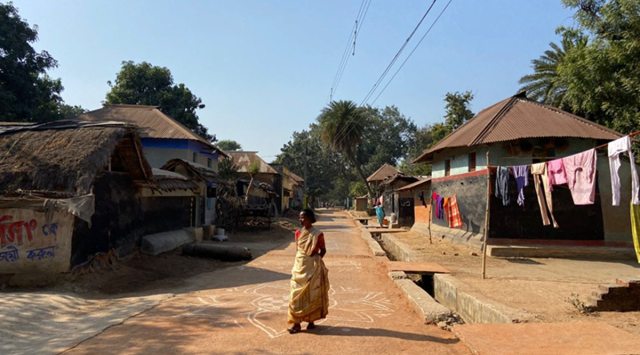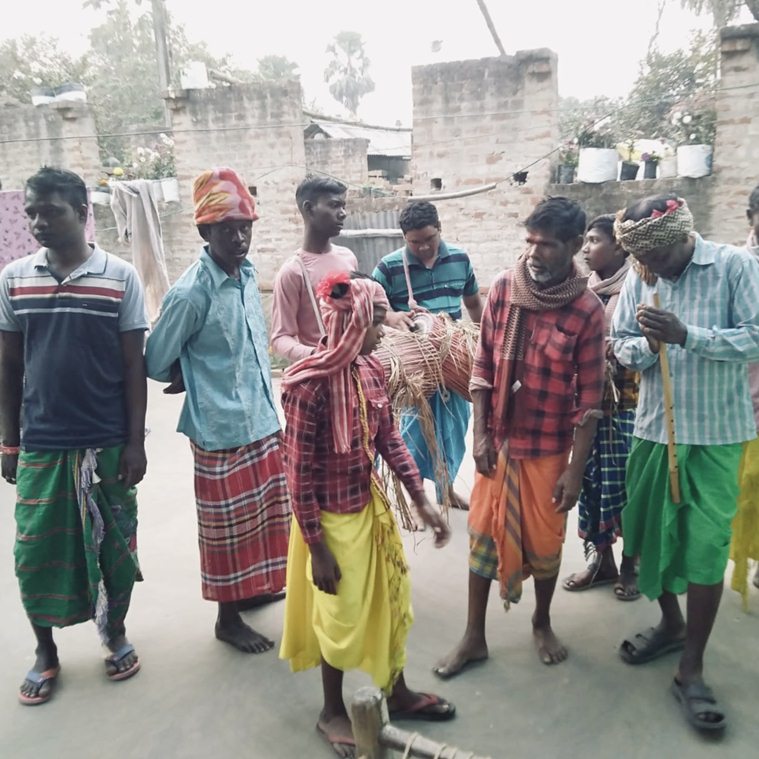Stay updated with the latest - Click here to follow us on Instagram
In rapidly changing times, Santals in West Bengal rethink how to preserve religious and cultural practices
The way Sohrae is celebrated, has been transforming in some villages in West Bengal, in big ways and small, because of changes that have happened within the Santal community.
 Ol designs painted outside homes in Balipara village, Birbhum, to celebrate Sohrae, the most important festival of the Santal community in eastern India. (Express photo by Neha Banka)
Ol designs painted outside homes in Balipara village, Birbhum, to celebrate Sohrae, the most important festival of the Santal community in eastern India. (Express photo by Neha Banka) In Balipara village located on land that is a part of Visva-Bharati University’s campus in Bolpur, 19-year-old Mungli Chore has been patiently drawing intricate alpona designs on the floor of her home using khari mati or white chalk powder. It is Um Hiloḱ, the first day of the Sohrae porob, the most important festival of the Santal community in eastern India, and the residents of Balipara are busy with preparations for the week ahead.
The festival is celebrated on the 25th day of Poush, the ninth month in the Bengali calendar, usually falling sometime between January and February every year. The Santals of Bankura, Purulia, Paschim Medinipur and Purba Medinipur districts and Odisha state, however, celebrate this festival during autumn, which has its own historical and socio-cultural background, says Dr. Boro Baski, a social worker based in Birbhum.
 Mungli Chore draws alpona or ol, as it is called in Santali, on the occasion of Sohrae porob outside her home in Birbhum, the most important festival of the Santal community in eastern India. (Express photo by Neha Banka)
Mungli Chore draws alpona or ol, as it is called in Santali, on the occasion of Sohrae porob outside her home in Birbhum, the most important festival of the Santal community in eastern India. (Express photo by Neha Banka)
According to oral folklore that has been passed down through generations that tells the story of the origins of Sohrae, when the Santal community needed livestock for agriculture and farming, they prayed to the Santal deity Marangburu who in turn answered their prayers. Therefore, every year during Sohrae, the community prays to Marangburu in thanksgiving, seeking the deity’s blessings for harvest, health, safety and prosperity.
Unlike other religious festivals in the community, however, Sohrae is always celebrated behind closed doors – that means it is not open to outsiders, Dr Baski says. But its format has been transforming in some villages in West Bengal, in big ways and small, because of changes that have happened within the community.
 Mungli Chore stands inside the courtyard of her home in Balipara village, Birbhum, after spending hours drawing intricate ol designs to celebrate Sohrae. (Express photo by Neha Banka)
Mungli Chore stands inside the courtyard of her home in Balipara village, Birbhum, after spending hours drawing intricate ol designs to celebrate Sohrae. (Express photo by Neha Banka)
Big changes and small
After dedicating some three hours to the task, Chore has covered just about all the ground possible, right from the intersection that marks the start of the narrow lane where she lives, to her home. Almost all houses in Balipara today, a village of approximately 250 families, have their own versions of the alpona or the ol in Santali language, some more elaborate than the others, but it was not always the case.
“Villagers have been creating these alpona since last year only. It is not traditionally a part of our cultural practices,” says Biswanath Kisku, 60, a librarian at Visva-Bharati University, as he greets his many friends while walking down the lanes of Balipara village.
 Ol designs painted outside homes in Balipara village, Birbhum, to celebrate Sohrae, the most important festival of the Santal community in eastern India. (Express photo by Neha Banka)
Ol designs painted outside homes in Balipara village, Birbhum, to celebrate Sohrae, the most important festival of the Santal community in eastern India. (Express photo by Neha Banka)
While these designs on the grounds of Balipara may have started only last year, likely the result of cultural influences of other communities that live around this village, within the Santal community, various clans have different practices associated with Sohrae, with the ol being a staple in some villages and not in others during these celebrations.
Nearby, is a jaher sthan, a demarcated location for the village’s place of worship. But three generations ago, it would have been located elsewhere, deep inside an agricultural field or a similar outdoor space.
 The jaher sthan of Balipara village in Birbhum, India. (Express photo by Neha Banka)
The jaher sthan of Balipara village in Birbhum, India. (Express photo by Neha Banka)
“Before Shantiniketan became so densely populated, it was largely agricultural land. Now, there is not even an inch of space left. These days, we have to demarcate spaces within our villages to practise our faith. Usually these religious practices happen outside the limits of the village but we don’t find space for that anymore,” says Kisku.
Adapting centuries-old customs
Within the Visva-Bharati University campus area, Balipara, Pearson Palli and Kallygaunge are three indigenous villages spread over approximately 50 acres of land, where mostly Santal families reside. Although there is little documentation available, village elders here remember stories passed down in their families of how the university’s founder and Nobel laureate Rabindranath Tagore, holding special affection for the Santal community that was spread across Birbhum district, invited them to set up villages in and around his university in the 1920s.
As the neighbourhood of Shantiniketan rapidly developed over the decades, land became a precious resource, pushing agricultural and forest land, integral to Santali culture and religious practices, further away from Bolpur town’s urban centre.
 The road that marks the entrance to Balipara village on the Visva Bharati University campus grounds in Bolpur town, Birbhum. (Express photo by Neha Banka)
The road that marks the entrance to Balipara village on the Visva Bharati University campus grounds in Bolpur town, Birbhum. (Express photo by Neha Banka)
“That is why we do this inside the villages these days. The jaher sthan and the gor tandi (cow shed) used to be located in separate places. Now our situation is such that we have to hold our religious practices in one single place. We are making compromises because these rituals are not done in the same place,” says Kisku.
But the issue is more complex, community members say, and the difficulties that the community faces in practising their religious customs cannot only be attributed to rapid urbanisation and socio-economic migration. “There is another issue. We are not allowed to practise these rituals in fields because land owners fear that if we are allowed to set up the jaher sthan in one corner of the field and practise the rituals, it would be akin to us occupying that property. But our festivals are deeply linked with harvest and agriculture, and so ideally the jaher sthan has to be in a field,” Kisku explains. Multiple reasons have compelled the community to accommodate the sacred jaher sthan in the next best place —within the peripheries of their village.
Changing lifestyles and many in the community choosing employment and professions outside their villages mean that families have been forced to change the way they adhere to their customary practices.
 The area around Bagnanpara village’s jaher sthan; the children of the village have decorated the space with balloons and streamers, an addition that would have been uncommon during the festival a few decades ago. (Express photo by Neha Banka)
The area around Bagnanpara village’s jaher sthan; the children of the village have decorated the space with balloons and streamers, an addition that would have been uncommon during the festival a few decades ago. (Express photo by Neha Banka)
One of these changes is in the rituals of gorubondhana, where the cow shed is worshipped as an important space within the home. “The festival of Sohrae is also deeply linked with cows, an important animal in agriculture for the community. The prayers and songs are called gayi jagao. These days it is hard to find cows and cow sheds in homes, but even in homes that don’t have the animals and the sheds, the songs are still sung because they are an important part of the culture,” Kisku says. If the cow shed is entirely absent, for instance in a home located inside an apartment building, the ritual is practised in a designated place as an alternative.
A few minutes away from Balipara, in Bagnanpara, a village of some 88 families, and the next door Seemantapally, where Kisku lives, the demographics have become more cosmopolitan, in part because of their proximity to the Visva-Bharati University campus. Many of the families here comprise indigenous as well as non-indigenous communities, and a large number of the residents have college degrees and full-time white-collar jobs in and around Bolpur town.
Days before Sohrae started, all around Bagnanpara’s jaher sthan, the village’s children came together to decorate the space with balloons and streamers, an addition that would have been uncommon during the festival a few decades ago.
 The residents of Bishnubati village in Birbhum, West Bengal, India gather in a field outside their village to mark the first day of Sohrae. (Express photo by Neha Banka)
The residents of Bishnubati village in Birbhum, West Bengal, India gather in a field outside their village to mark the first day of Sohrae. (Express photo by Neha Banka)
In keeping with tradition
In Bishnubati village, approximately an hour’s drive from Bolpur, the first day of Sohrae is being marked in the fields outside, strictly adhering to customs, with the manjhi or the village head overseeing the ceremony.
On the morning of Um Hiloḱ, villagers in Bishnubati, along with their children, have collected batches of rice, pulses, potatoes, cooking oil, salt, chilli, firewood and a hen from every family in the village, all of which is to be later cooked together in a customary practice. The village priest or the naeke oversees the sacrifice of the birds in commemoration of the spirits of ancestors and of the abiding spirits of the village. A few hours before dusk is about to fall, it is time for a ritual that the children of Bishnubati village seem most enthusiastic for: the cooking of the sura.
 Residents of Bishnubati village prepare sura in a wok in the middle of an open field on the first day of Sohrae in Birbhum. (Express photo by Neha Banka)
Residents of Bishnubati village prepare sura in a wok in the middle of an open field on the first day of Sohrae in Birbhum. (Express photo by Neha Banka)
In the middle of an open field on the outskirts of Bishnubati, a large cast iron wok is heated and the cooking of the sura begins, a dish that resembles khichdi and other similar porridges, where the collected grains, potatoes, condiments and sacrificed hen are cooked together, all of which is expected to be consumed in the fields itself by the men and children of the village. The cooked sura is then served on leaves of the palmyra palm, along with handia, a fermented rice beer that is integral to religious and social gatherings in the Santal community.
 The cooked sura is served to residents of Bishnubati on leaves of the palmyra palm. (Express photo by Neha Banka)
The cooked sura is served to residents of Bishnubati on leaves of the palmyra palm. (Express photo by Neha Banka)
Bishnubati is one of those few villages in West Bengal that has consciously attempted to preserve the community’s customs and practices, in part because Dr. Baski and his associates have been working tirelessly to generate more awareness about the need to preserve tangible and intangible Santali heritage, in their village and outside.
Although Sohrae has traditionally been a festival celebrated privately, only within the community, Dr. Baski says that in Bishnubati, the residents have attempted to open it to outsiders to generate more awareness and sensitivity of Santal culture and identity.
 The cooked sura is served to residents of Bishnubati on leaves of the palmyra palm. (Express photo by Neha Banka)
The cooked sura is served to residents of Bishnubati on leaves of the palmyra palm. (Express photo by Neha Banka)
”We are concerned about whether the present generation is interested in learning about our culture and carrying it forward. They are more drawn towards things like mobile phones and aren’t interested in learning about our songs and practices. We are seeing it happening in many villages,” says Bimal Baski, a primary school teacher and the caretaker of the Museum of Santal Culture in Bishnubati.
“These days during Sohrae, in some villages, the youth will bring a DJ and a music box, microphones and speakers and play random music. But that isn’t what Sohrae is about. Sohrae needs traditional Santali musical instruments. The youth feel that it is difficult to learn these instruments and they seek the convenience of the DJ,” Bimal says.
 Teenage boys from Bishnubati village skilfully fold leaves of the palmyra palm into elaborate cups that are used to serve handia. (Express photo by Neha Banka)
Teenage boys from Bishnubati village skilfully fold leaves of the palmyra palm into elaborate cups that are used to serve handia. (Express photo by Neha Banka)
A few steps away from the large wok where the sura is being cooked, a group of teenage boys deftly fold and weave leaves of the palmyra palm into elaborate cups called ‘taal paatar thola’ in Bengali for serving handia, a skill in the Santal community that not all children want to learn these days. “In our village, the youth still learn traditional crafts and aspects of the Santal way of life, because there has been a conscious effort to teach them,” says Bimal.
While the village elders sit for lunch with helpings of sura and cups of handia, Bimal talks about the challenges that Santals who have migrated out of their villages for employment, face when it comes to preparing handia, an integral part of Santali customs. “It is also hard to find handia in cities and so many times we see that the community isn’t able to prepare it and use it for religious practices,” Bimal says.
 Residents of Bishnubati village filter handia using a muslin sieve, just before serving the drink. (Express photo by Neha Banka)
Residents of Bishnubati village filter handia using a muslin sieve, just before serving the drink. (Express photo by Neha Banka)
The fermentation process of handia takes at least a week, and needs an earthen pot in a specific shape and bakhor, a starter agent for fermentation, which are difficult to find outside Santal villages. “So even if they don’t get the earthen pots that we use, they will take bakhor tablets from the village and prepare handia in steel pots. My brother in Bandel does it in a similar way,” says Bimal.
Back in Bolpur, sitting on the terrace of one of Visva-Bharati University’s campus buildings, Kisku has been thinking about the less visible shifts that have come in the community, in part because this year, he was appointed community leader in Seemantapally village, where he oversees community events like weddings, funerals and births. Kisku says that he is not religious, but still ensures that his family follows rituals and customs to do their part in saving them.
 A young resident of Bishnubati village serves a village elder some handia in a palmyra palm cup, holding his right arm with his left hand in a mark of respect, on the first day of Sohrae. (Express photo by Neha Banka)
A young resident of Bishnubati village serves a village elder some handia in a palmyra palm cup, holding his right arm with his left hand in a mark of respect, on the first day of Sohrae. (Express photo by Neha Banka)
Going back to the roots
“Change is coming, but at the same time, there is also a rethinking that the community needs to preserve its own culture. There are people in the community who believe that we have our own language, our socio-cultural practices and heritage that needs to be conserved,” Kisku says.
 Residents of Bishnubati village perform traditional Santali songs with traditional instruments during the Sohrae festival in Birbhum. (Photo by Bimal Baski)
Residents of Bishnubati village perform traditional Santali songs with traditional instruments during the Sohrae festival in Birbhum. (Photo by Bimal Baski)
In the Santal community, language and knowledge have traditionally been taught through oral education, passed down from elders in the family, which makes the need for its documentation and preservation even more important. “My children don’t know our songs. It is really our fault. I do have regrets because my children can’t speak Santali. For a long time, the community focused on teaching its children Bengali and educating them in Bengali-medium schools. So much so that now they can’t even speak the language, let alone being able to sing the songs,” Kisku says.
 A group of girls and women dancing during the festival of Sohrae in Birbhum. (Photo by Biswanath Kisku)
A group of girls and women dancing during the festival of Sohrae in Birbhum. (Photo by Biswanath Kisku)
“When people began leaving their villages to study and work in the big cities, there was nobody in these villages who could do something for the community or take on the roles of community leaders,” he says. But then, some 10 to 15 years ago, there were people who realised that as a community there was a pressing need to protect and preserve Santali heritage to prevent it from being lost forever. “Now, educated Santals are going back to their roots to hold on to their practices, language and customs,” Kisku says, one village at a time.












